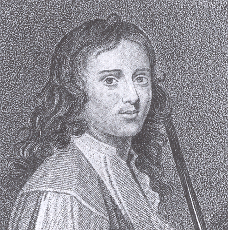
Sir William Davenant, also spelled D'Avenant, was an English poet and playwright. Along with Thomas Killigrew, Davenant was one of the rare figures in English Renaissance theatre whose career spanned both the Caroline and Restoration eras and who was active both before and after the English Civil War and during the Interregnum.
This article contains information about the literary events and publications of 1677.
This article contains information about the literary events and publications of 1669.
This article contains information about the literary events and publications of 1667.
This article contains information about the literary events and publications of 1660.

Roger Boyle, 1st Earl of Orrery, 25 April 1621 to 16 October 1679, was an Anglo-Irish soldier and politician. A younger son of the Earl of Cork, the largest landowner in Munster, like many Irish Protestants he supported the Dublin Castle administration during the Irish Confederate Wars, a related conflict of the Wars of the Three Kingdoms.

Michael Mohun was a leading English actor both before and after the 1642–60 closing of the theatres.
Charles Hart was a prominent British Restoration actor.

Lisle's Tennis Court was a building off Portugal Street in Lincoln's Inn Fields in London. Originally built as a real tennis court, it was used as a playhouse during two periods, 1661–1674 and 1695–1705. During the early period, the theatre was called Lincoln's Inn Fields Playhouse, also known as The Duke's Playhouse, The New Theatre or The Opera. The building was rebuilt in 1714, and used again as a theatre for a third period, 1714–1732. The tennis court theatre was the first public playhouse in London to feature the moveable scenery that would become a standard feature of Restoration theatres.
Henry Herringman (1628–1704) was a prominent London bookseller and publisher in the second half of the 17th century. He is especially noted for his publications in English Renaissance drama and English Restoration drama; he was the first publisher of the works of John Dryden. He conducted his business under the sign of the Blue Anchor in the lower walk of the New Exchange.

The Duke's Company was a theatre company chartered by King Charles II at the start of the Restoration era, 1660. Sir William Davenant was manager of the company under the patronage of Prince James, Duke of York. During that period, theatres began to flourish again after they had been closed from the restrictions throughout the English Civil War and the Interregnum. The Duke's Company existed from 1660 to 1682, when it merged with the King's Company to form the United Company.
Claricilla is a Caroline era stage play, a tragicomedy written by Thomas Killigrew. The drama was acted c. 1636 by Queen Henrietta's Men at the Cockpit Theatre, and first published in 1641. The play was an early success that helped to confirm Killigrew's choice of artistic career.
Anne Marshall, also Mrs. Anne Quin, was a leading English actress of the Restoration era, one of the first generation of women performers to appear on the public stage in England.
Katherine Corey was an English actress of the Restoration era, one of the first generation of female performers to appear on the public stage in Britain. Corey played with the King's Company and the United Company, and had one of the longest careers of any actress in her generation. In "The humble petition of Katherine Corey", she stated that she "was the first and is the last of all the actresses that were constituted by King Charles the Second at His Restauration."
As You Find It is a 1703 comedy play by the English writer Charles Boyle, later Earl of Orrery. His grandfather Roger Boyle, 1st Earl of Orrery had also been a playwright. In style it is much closer to traditional Restoration comedy, than the developing trend for Sentimental comedy.
John Young was an English stage actor of the seventeenth century. He was active as a member of the Duke's Company during the Restoration Era, appearing at Lincoln's Inn Fields and then at the Dorset Garden Theatre when the company relocated. While not much is known about his background, he was repeatedly in debt during his acting career. In 1667 he stood in for Thomas Betterton after he fell ill during the run of Macbeth appearing as the title role. Samuel Pepys described him as "a bad actor at best".

Tryphon is a 1668 tragedy by the Irish writer Roger Boyle, 1st Earl of Orrery. It was originally staged by the Duke's Company at the Lincoln's Inn Fields Theatre in London. The original cast is unknown.
Mustapha, The Son Of Solyman The Magnificent is a 1665 tragedy by the Irish writer Roger Boyle, 1st Earl of Orrery. It was first performed by the Duke's Company at the Lincoln's Inn Fields Theatre in London. It is based on the life of Şehzade Mustafa, son of Suleiman the Magnificent who had him executed.
King Edward The Third; With The Fall Of Mortimer, Earl Of March is a 1690 tragedy, generally attributed to the English writers John Bancroft and William Mountfort. It was first performed by the United Company at the Theatre Royal, Drury Lane in London. It portrays the early years of the reign of Edward III and his defeat and execution of Roger Mortimer, Earl of March.





